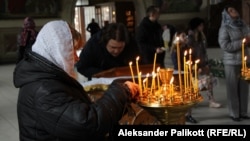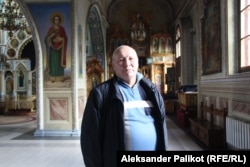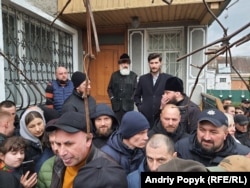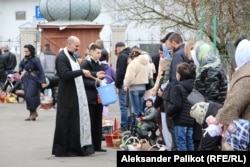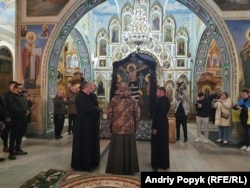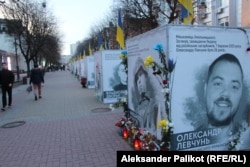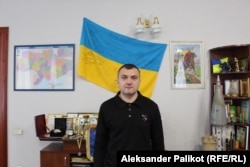KHMELNYTSKIY, Ukraine -- Two weeks before residents of this quiet city in the west of Ukraine gathered around its main cathedral for the traditional Easter baskets blessing, a brawl broke out between a priest and a soldier inside the building, sending shock waves throughout the region and the entire country.
"How many more people need to die for you to stop going to the Moscow Patriarchate?" former military medic Artur Ananyev asked more than 100 believers present in the cathedral run by the Ukrainian Orthodox Church (UOC), the Moscow-linked church that dominated Ukraine for decades.
Accounts of what happened after Ananyev spoke are contradictory: He says he was physically assaulted by cleric Ihor Slobodyan; the priests initially claimed they "attempted to stop" Ananyev because he threw a bible on the ground. But after the publication of a video clip showing one of them dropping the holy book on the floor, they shifted to accusing the soldier of spilling holy water.
Footage filmed by an unidentified parishioner and published separately by Viktor Burlyk, Ananyev's former brother-in-arms from the volunteer 19th Separate Rifle Battalion and a deputy of the Khmelnytskiy Regional Council, instantly went viral on social media.
The recording shows a man in a purple cassock, later identified as Slobodyan, kicking Ananyev, several men twisting his arms, forcibly frog-marching him from the ornate cathedral, and pressing down on his body as he lies prone on the floor at the entrance. It also shows an elderly woman slapping him in the face, and another woman pleading with them to stop and call the police. At the end, Ananyev, lying on the floor with blood on his brow, says, "I can't breathe," and Slobodyan replies, "I don't give a f*** if you can or cannot."
The police patrol that arrived at the scene decided to file an administrative report against Ananyev, 25, for hooliganism. Only the following day, when Ananyev -- who was diagnosed with a traumatic head injury and brain contusion at the local hospital -- filed a complaint, did national police open two criminal cases against his attackers, on charges of hooliganism and inflicting light bodily harm.
"I didn't know that somebody was filming," Ananyev told RFE/RL, recalling the day of the brawl over a week later at the veterinary clinic where he works. "If it wasn't for that, people might have believed the lies of the priests, and all this might not have happened."
He was referring to the ensuing events, which the local newspaper Proskuriv described as "the fall of the Moscow church."
Just one day after the violent incident, priests of the UOC were gone from the cathedral. The building and the parish are now in the hands of the Orthodox Church of Ukraine (OCU), which was granted independence in 2019 and is gaining parishioners and property.
Its rival, meanwhile, is losing its footing in a country where Moscow’s deadly war of aggression has made any association with the Russian state and the Russian Orthodox Church toxic.
Countrywide Confrontation
"The beating of a soldier and the blatant lies about it were the sparks that ignited the fire, but the anger at the Moscow priests had been smoldering for a long time," Andriy Popyk, a local activist and blogger, told RFE/RL.
The events in Khmelnytskiy unfolded against the backdrop of the countrywide confrontation with the Moscow-linked church -- a conflict whose roots reach back to 1991, when Ukraine gained independence as the Soviet Union collapsed, but escalated last autumn in the wake of Russia's unprovoked, large-scale invasion of Ukraine in February 2022.
Known until recently as the Ukrainian Orthodox Church-Moscow Patriarchate, the UOC was nominally autonomous but was subordinate to the Russian Orthodox Church. It severed ties with Moscow in May 2022, citing opposition to the invasion, but the church and clerics within it have been accused of maintaining those links, upholding pro-Russian narratives, and collaborating with occupying forces in Russian-held parts of Ukraine.
In December, President Volodymyr Zelenskiy vowed to introduce measures to protect his country's "spiritual independence" from the Russian Orthodox Church -- which is led by Patriarch Kirill of Moscow, a loyal ally of Russian President Vladimir Putin who has unequivocally backed Russia's war on Ukraine.
In a poll conducted by the Kyiv International Institute of Sociology (KIIS) in December, as many as 78 percent of Ukrainians said the state should intervene in the activities of the UOC, and 54 percent said it should be banned altogether.
The events at Khmelnytskiy Cathedral came as tensions rose at a far more prominent center of Orthodoxy in Ukraine -- Kyiv-Pechersk Lavra, or the Monastery of the Caves, a sprawling complex in the capital that UNESCO calls "one of the most important Christian pilgrimage centers in the world."
Three days before Ananyev's beating, UOC clerics refused to leave Kyiv-Pechersk Lavra despite an eviction order from the authorities. On the eve of the brawl in Khmelnytskiy, the Kyiv monastery's abbot, Metropolitan Pavlo -- dubbed "Pasha Mercedes" by detractors because of what appears to be a lavish lifestyle -- was placed under house arrest for 60 days as prosecutors investigate him on suspicion of inciting religious hatred and justifying Russia's aggression against Ukraine.
Amid concerns about the possibility of a violent confrontation that could damage Ukraine's image, the secretary of the National Security and Defense Council, Oleksiy Danilov, declared that monks refusing to leave the historic site in the heart of the capital would not be evicted by force. Weeks later, many remain.
Unlike in the case of Kyiv-Pechersk Lavra, though, the UOC priests at Khmelnytskiy Cathedral were evicted in less than a day. The move was branded a "raider seizure" or hostile takeover by the UOC and hailed as a "long-awaited act of justice" by Yuriy Smal, a regional lawmaker from the nationalist Svoboda party who played an instrumental role in the process.
RFE/RL made several attempts to contact various representatives of the UOC in the Khmelnytskiy region, but none of them agreed to comment on the recent events.
Religious Maidan
Within hours of the publication of the brawl video, well over 1,000 angry residents -- as many as 4,000, according to some eyewitnesses -- came to the cathedral. According to Popyk, who was present there, it was the largest demonstration in Khmelnytskiy, a city with a population of over 274,000 people, since the Euromaidan -- the massive pro-European, anti-corruption protest that movement that pushed Moscow-friendly President Viktor Yanukovych from power in 2014.
Andriy Kolesnyk, a 21-year-old history student whose father is fighting in the 19th Separate Rifle Battalion, told RFE/RL that when he joined the protest, there was "literally no place to put one's feet because of the number of people coming to the cathedral." Alongside ordinary citizens stood prominent local figures, activists, and soldiers, he said.
Demonstrators chanted, "Away with the Moscow priests," "Shame!" and "Glory to Ukraine!" The cathedral’s windows were covered with posters showing a still frame from the video of Ananyev's beating. A white banner with "KGB" written in red letters appeared on a side entrance often used by the priests -- a reference to tight Soviet-era ties between the secret police and the Russian Orthodox Church.
Once he learned about the people coming to the cathedral, Smal told RFE/RL, he brought six tables there and announced a petition for the transition of the parish from the UOC to the pro-Kyiv OCU.
Smal, 67, was the commander of a "self-defense unit" established to protect demonstrators from government forces and provocateurs during the local Euromaidan protests, and he met the then-16-year-old Ananyev, who was among the many young people involved in the demonstrations, at the time. After the full-scale Russian invasion in February 2022, Smal helped to create the 19th Separate Rifle Battalion, the volunteer unit that Ananyev joined.
Smal has also been involved in religious life in Khmelnytskiy for many years. He had contributed to the construction of the Cathedral of the Intercession of the Blessed Virgin Mary in the 1990s and tried to convince Metropolitan Antoniy, head of the diocese, to leave the Moscow-linked church in 2018, when the OCU was created in a merger of the Ukrainian Autocephalous Orthodox Church and the Ukrainian Orthodox Church-Kyiv Patriarchate.
After that merger, in 2019, Patriarch Bartholomew of Constantinople, the spiritual head of Orthodox Christianity's 300,000-strong global community, granted the new church independence from the Moscow Patriarchate and the Russian Orthodox Church.
That momentous shift angered the Kremlin and the Russian Orthodox Church and added to severe strains in ties between Moscow and Kyiv, already deeply at odds since 2014, when Russia responded to Yanukovych's downfall by seizing Crimea and fomenting a separatist war in eastern Ukraine's Donbas region. In parishes across Ukraine, it gave the new church clout and intensified struggles between the OCU and the UOC-Moscow Patriarchate over church property and the loyalty of the faithful.
In a matter of hours, 1,225 residents had voted in favor of the transition to the OCU in Khmelnytskiy. The procedure is legal under a 2019 law that recognizes the right of a religious community to change its subordination by a vote among its members, but it is not clear whether all those who voted were parishioners.
The protesters also elected a commission responsible for auditing the cathedral property and indicated that Smal would lead it. The commission later said it had found a number of books in the cathedral library espousing Russian imperialism, with titles including The Battle For Russia and Russia Before The Second Coming, as well as works by Ivan Ilyin, a 20th-century Russian thinker who is widely considered a fascist and has been praised by Putin. It also found anti-vaccination brochures.
Metropolitan Antoniy watched the unfolding events from his nearby home, surrounded by fellow priests. According to Smal, after seeing the list with parishioners' signatures, the 77-year-old bishop agreed to hand over the keys to the cathedral, saying he would not oppose the people's will. "He had no choice. Justice was on our side, and we were the majority," Smal told RFE/RL.
None of the remaining priests decided to switch to the pro-Kyiv church, and Antoniy was dismissed by his UOC superiors the following day. Only the members of the choir chose to stay at the cathedral.
"The Moscow Patriarchate in Ukraine is nonsense -- I've waited for this moment for 30 years," Tetyana Brytska, 65, who came to the cathedral for the Easter baskets blessing, told RFE/RL. Another woman, Alla, 71, who did not want her surname published, said she did not "support the transition to the new church" but came for the blessing anyway.
Confessional Tension
Reflecting back on the events that unfolded after a brawl in the cathedral, Ananyev told RFE/RL that he is gratified that "the people of Khmelnytskiy finally saw the true face of the Moscow church."
The fight at Khmelnytskiy Cathedral wasn't the first time Ananyev and Slobodyan -- who fled the city and is now hiding from the police -- had confronted each other. The former was a member of Feniks, a nationalist organization that originated from the youth branch of the Svoboda party, and the latter belonged to the Brotherhood of Saints Antonius and Theodosius of the Kyiv Caves, an organization of staunch supporters of the UOC.
Since 2018, members of the two organizations have intervened -- on opposite sides -- in parishes that wanted to change subordination. According to Popyk, the Brotherhood was hiring thugs to prevent local communities from leaving the Moscow-loyal church.
On the evening of the day of the brawl, a service in Ukrainian -- for the first time in 30 years -- was held at Khmelnytskiy Cathedral. It was led by Danyil Tarnavskiy, 41, a military chaplain who in the past was a UOC priest at Khmelnytskiy Cathedral but switched to the pro-Kyiv church six years ago.
Tarnavskiy, who became an altar boy at age 6 and a priest at 20, says that what he called the authoritarian and strictly hierarchal nature of the UOC has prevented many well-meaning and pro-Ukrainian priests from rebelling against their older, more pro-Russian superiors.
He told RFE/RL that he switched denominations because he came to understand that in light of the war between Ukraine and Russian-backed separatists in the Donbas, he could not be a patriot and remain a priest of the Russian-linked church.
The day after the first service in Ukrainian, the funeral of Maksym Kolaches, a 25-year-old architect and volunteer soldier, was held at the cathedral. It was the first funeral of a Ukrainian soldier killed fighting Russian troops to take place in the temple since the war in the Donbas broke out in 2014. The UOC had refused to hold funerals for Ukrainian soldiers there, a stance that angered residents and contributed to the protests in Khmelnytskiy.
Tarnavskiy, who serves as a chaplain for the soldiers in the Khmelnytskiy region, said that he holds at least one funeral every day for a soldier killed in the war.
Unanimous Eviction
On the eve of the Easter celebrations, Khmelnytskiy's central Proskurivska Street was uncrowded, although the city -- the center of a region hosting 110,000 internally displaced people -- remains relatively lively. Along the street, passersby leave flowers and candles at the foot of a row of cube-shaped stands bearing portraits of soldiers from the city who have been killed in the war.
"I want the people to look into the eyes of our heroes when they go about their business in the city," Oleksandr Symchyshyn, Khmelnytskiy's mayor, told RFE/RL.
Symchyshyn, whose background is in the Svoboda party and the nationalist movement, was first elected in 2015 and is in his second term after winning 87 percent of the vote two years ago.
A flag of the self-proclaimed "Luhansk People's Republic" -- the Russian-backed separatist entity in the Luhansk region in the Donbas, which Moscow now groundlessly claims as part of Russia -- lies on the threshold of his office and serves as a doormat for visitors. The spacious room is filled with various memorabilia and detritus of war brought from the front line.
"This is what the so-called Russian World is at its heart," he said, pointing at part of a rocket picked up from the battlefield. "Death, destruction, and misery."
Two days after Ananyev's beating, the Khmelnytskiy city council voted unanimously to terminate the UOC's right to use the land under the cathedral, as well as 12 other plots.
The regional council followed suit: In a unanimous vote, its members banned UOC activity in the Khmelnytskiy region and recommended that local governments conduct inventories of land plots used by the UOC and help the communities to transfer them to the OCU.
Similar decisions were made in the following weeks by the councils in three other regions in western Ukraine: Rivne, Volyn, and Chernivtsi.
According to religious scholar Dmytro Horyevoy, the decision of the Khmelnytskiy Regional Council deputies to ban the UOC has no legal force, as only a court can issue such a ruling. "The decision concerning land plots is a tricky way to limit church activities without banning them," he told RFE/RL.
Horyevoy says the events in Khmelnytskiy initially got out of control of the central authorities, which do not want tensions over the "religious issue" to escalate into violence. But "for now, it seems that escalation has been prevented," he said.
Within two weeks, the transition of Khmelnytskiy Cathedral was followed by three other churches in the city and five in the broader region. There are more than 560 UOC churches left in the Khmelnytskiy region, but the rate of transitions to the OCU is accelerating.
Since Russia's invasion in February 2022, more than 700 parishes in Ukraine have switched from the UOC to the OCU. The transition is even more visible at the level of individual believers: according to the KIIS survey, the number of Ukrainians who identified as members of the OCU grew from 34 percent in June 2020 to 54 percent in July 2022, while the Moscow-linked church saw a drop from 18 percent to 14 percent in this period.
Symchyshyn vocally supports the measures taken against the UOC, which he called an "FSB nest" -- a reference to Russia’s Federal Security Service, the main successor of the KGB -- that is responsible for "an anti-Ukrainian sabbath."
"What we are going through is a natural process," he said, arguing that "Russia has been using the church as a tool of political control, and after the full-scale invasion, everybody understands that there can be no place for it in Ukraine."




